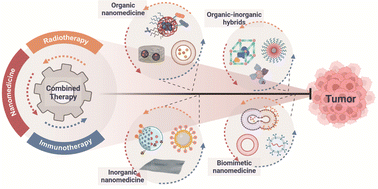Nanomedicine embraces cancer radio-immunotherapy: mechanism, design, recent advances, and clinical translation
Abstract
Cancer radio-immunotherapy, integrating external/internal radiation therapy with immuno-oncology treatments, emerges in the current management of cancer. A growing number of pre-clinical studies and clinical trials have recently validated the synergistic antitumor effect of radio-immunotherapy, far beyond the “abscopal effect”, but it suffers from a low response rate and toxicity issues. To this end, nanomedicines with an optimized design have been introduced to improve cancer radio-immunotherapy. Specifically, these nanomedicines are elegantly prepared by incorporating tumor antigens, immuno- or radio-regulators, or biomarker-specific imaging agents into the corresponding optimized nanoformulations. Moreover, they contribute to inducing various biological effects, such as generating in situ vaccination, promoting immunogenic cell death, overcoming radiation resistance, reversing immunosuppression, as well as pre-stratifying patients and assessing therapeutic response or therapy-induced toxicity. Overall, this review aims to provide a comprehensive landscape of nanomedicine-assisted radio-immunotherapy. The underlying working principles and the corresponding design strategies for these nanomedicines are elaborated by following the concept of “from bench to clinic”. Their state-of-the-art applications, concerns over their clinical translation, along with perspectives are covered.



 Please wait while we load your content...
Please wait while we load your content...